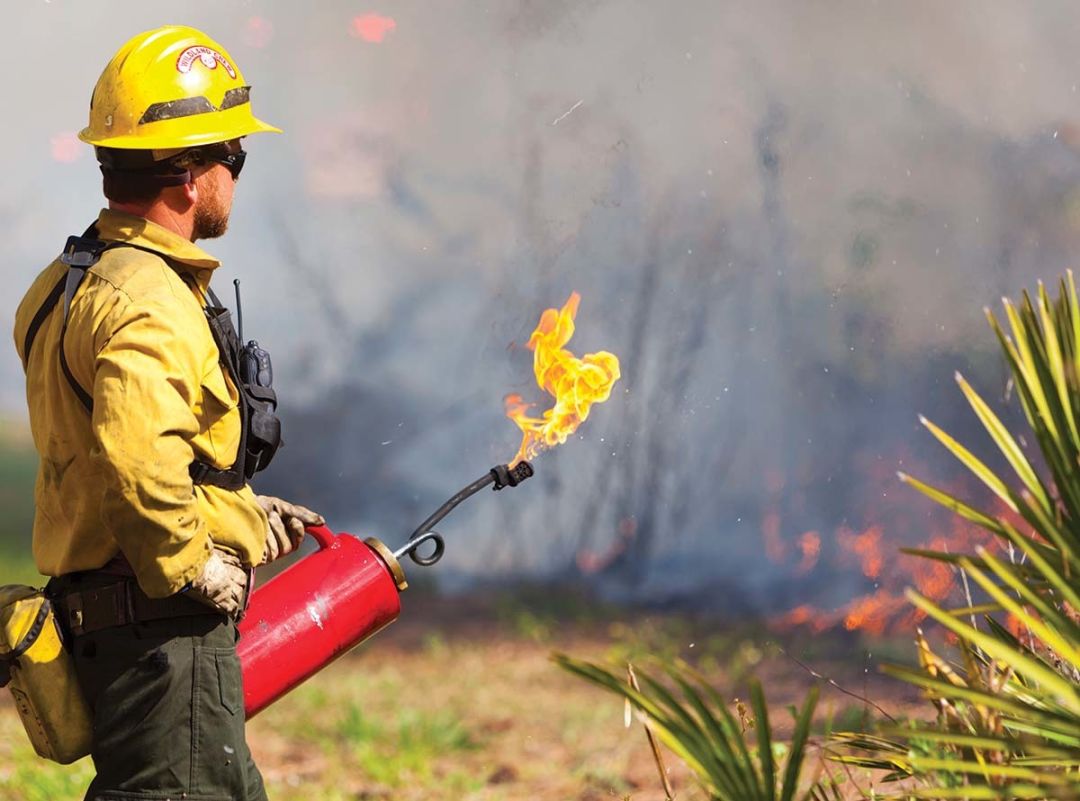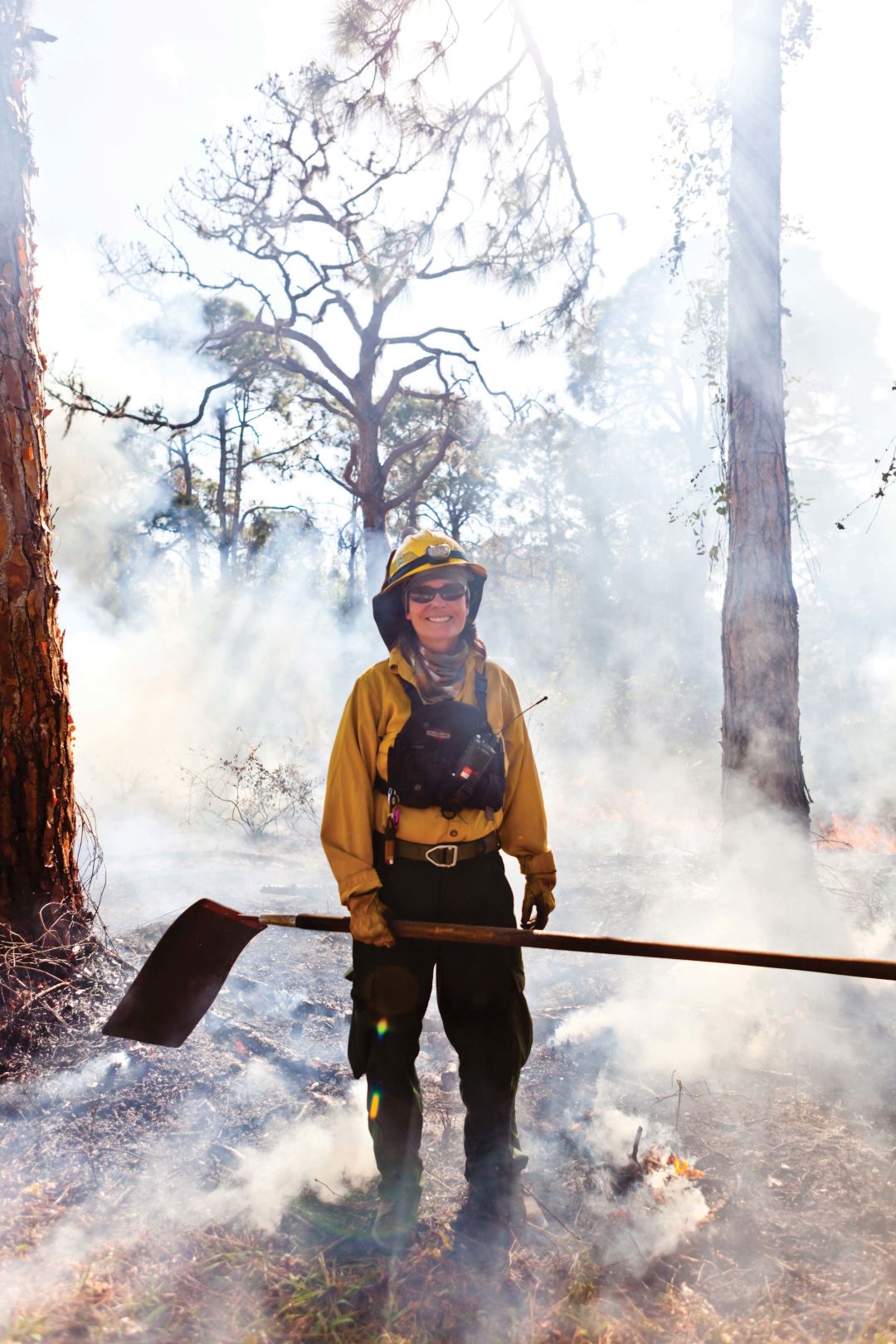
Florida Is Burning, Too. But It's on Purpose.
Editor's note: This article originally appeared in the March 2020 issue of Sarasota Magazine.
On a warm March afternoon at Lemon Bay Park, I watched a fire turn bright-green saw palmettos orange. It charred cabbage palm trunks, and flames jumped 20 feet to torch low hanging fronds. A wall of heat pushed out, and smoke billowed onto a nature path where passing hikers used their shirts to cover their mouths and noses. Tidy suburban houses stood fewer than a hundred yards away. Standing near the flames were a dozen members of the Sarasota County Fire Department. But they weren’t putting the fire out. They started it.
“We set good fires, or else we get bad ones,” says Jay Bailey, who, until he retired in 2024, was Sarasota County’s wildfire mitigation officer. Bailey estimates he’s burned more than 100,000 acres of Sarasota’s wooded lands in his 20-year career. He and his crew walked along the vegetation with drip torches, metal canisters full of diesel with a lit flame at the end, pouring shots of liquid fire on the plants to steer the direction of the flames. Trailing behind them was a truck filled with a thousand gallons of water, soaking the bases of pine trees and putting out any stray fires still burning.
Purposefully setting fires seems like the last thing we should be doing. In 2020, Australia experienced catastrophic fires that burned 16 million acres and killed dozens of people and nearly a billion animals. The Amazon is still burning, and wildfire whipped across the Arctic last year. In 2019, the hellfire in Paradise, California, killed 85 people, left thousands homeless and charred more than 150,000 acres of wooded hillside. And this year, fires have ravaged Los Angeles—the Eaton and Palisades blazes have killed at least 11 people and burned more than 36,000 acres. Experts say the two fires are some the worst in California's history.
Yet Florida, this flat state of intense heat, scrubland, winds from the ocean and Gulf, drought and 21 million people, has not gone up in flames. At least not by accident. In 2018, Florida intentionally burned more than 2.4 million acres of land, more land than any other state in the country. That’s roughly two and a half times the size of Rhode Island.
“Florida should be celebrated,” says Stephen J. Pyne, an emeritus professor at Arizona State University and one of the foremost historians of fire. “Florida is a leader in American fire management.” If Florida didn’t burn, he says, vegetation would grow out of control, and lightning would ignite fires even if humans didn’t. “Florida did two things right,” Pyne says. “First, it set aside land for conservation. Second, it pushed for prescribed fire.”
While Florida is often at the bottom of U.S. rankings like public school spending, child wellbeing and wages, Florida’s fire management is an ideal model that the rest of the country ought to study. California developed by suppressing fires and developing in areas that historically burned. The result is a state on the edge of incineration. Pyne’s solution for Southern California is 10 times more fire, like the kind you find in Florida. California isn’t a carbon copy of Florida, Pyne admits, since the Sunshine State doesn’t have many conditions where you can’t burn and it’s hard to over-burn. But what California should copy is Florida’s will to burn, he says.
But Florida wasn’t always this way.

A firefighter with a drip torch.
Image: Gene Pollux
Throughout Florida’s history, its ecology has been entangled with fire. The state’s sandy soil sits atop porous limestone that makes for rapid drainage, allowing the land to quickly dry and then burn. And rather than keep fire at bay, the rain that wets Florida assures that something is always growing. All that growth means there is always something to burn, even in dampness. Wetlands burn. Duff, the decaying, organic material on forest floors, burns at 100 percent relative humidity. Saw palmetto, the small palms of subtropical Florida mentioned earlier, can burn soon after a heavy rain.
It’s not hard to find a matchstick. Florida is the lightning capital of the nation. Besides lightning, man is the only other ignition for fire. The people who inhabited Florida 5,000 years ago used fire to clear land. Over these thousands of years, our flora and fauna adapted to a life of fire, natural and manmade.
It is only in recent history that we tried to stop fires. In 1910, the Big Blowup, a fire in western Montana and northern Idaho, burned more than 3 million acres in three days. After this, the newly created U.S. Forest Service implemented a policy of fire exclusion. It discouraged the ancient traditions of setting fire to the land and, at the same time, organized to fight fires that happened naturally. Starting in the early 1930s, the Florida Board of Forestry traveled around the state promoting a program of fire prevention. They banned woodsburning—a tradition of fire management inherited from indigenous people and adopted by homesteaders, farmers and ranchers—on all public lands. In 1934, the New Deal’s Civilian Conservation Corps took charge of state parks and applied this anti-fire ideology to our state parks, including Myakka River State Park.
The park became a flagship site for Florida’s protected state lands where the policy of fire suppression was strictly enforced. The state planted trees in the park, and prairie turned into forest. Pine trees grew uncomfortably close together while saw palmetto choked the park’s floor. The state allowed private landowners and ranchers to burn, but these landowners were liable for any property or smoke damage that resulted.
As Florida’s population increased, people moved inland, away from the coast. Many of these newcomers were urban and suburban retirees from the Northeast and the Ohio Valley, places where natural fire was rare. In places like Myakka, these new immigrants came face to face with ranchers and their woodsburning. They thought the practice was being done by “demented” woodsmen and belonged with “folk medicine, squirrel hunting, and snake handling,” as Pyne wrote in his book, Florida: A Fire Survey.
One of those “woodsmen” is Jim Strickland, a 64-year-old Florida-born rancher who owns the Strickland Ranch and Blackbeard’s Ranch, a 4,530-acre operation bordering Myakka State Park. In 2019, Audubon Florida named Strickland “Sustainable Rancher of the Year” for his environmentally sustainable ranching practices and wildlife conservation. Strickland started burning when he was 10 years old.
“I learned at the feet of my father,” Strickland says. “Coming out of the winter, the cows needed green grass, so we’d walk for miles with fire pots burning woods and dried prairie.” Once the duff had burned away, the grass quickly grew. When Strickland’s father needed to burn more ground, he’d send his boy to the store to buy every box of kitchen matches in stock. Then young Strickland and the crew put all the matches in 50-pound burlap sacks, hung them over the front of their horses’ necks and rode along lighting matches to ignite the woods.
“I was learning with woodsmen, watching the clouds and the wind,” he says. “We knew how to do back burns and have a safe area. We’d light the fire with a headwind. That was the way we burned.”
Even in the late 1960s, there wasn’t much for Strickland to be worried about. I-75 hadn’t been built yet, so there was no fear of smoke billowing onto the freeway and causing accidents. If you burned your neighbor’s land, that was all right, too, because your neighbor was probably going to burn it anyway.
But as more cattle ranchers were replaced with tourists and affluent retirees living on small lots, less private land was being burned. Without fire, the big prairie turned into a big palmetto patch. The Florida grasshopper sparrow, burrowing owl, Sherman’s Fox squirrel and crested caracara disappeared. “The original domain was choking on an obese, rough and thickening saw palmetto,” Pyne wrote, “and ecologically suffering as if from biotic diabetes.”
These ecological changes alarmed foresters, hunters and conservationists. They began to pressure legislators that fire prevention was destructive and dangerous. Making matters worse, large rural properties all over the state held by absentee owners were overgrown and had become fire hazards. Finally, by 1977, the state of Florida recognized the risk and passed the Hawkins Bill, giving power to the Florida Forest Service to expand its prescribed burns to private property. “This was pretty astonishing,” Pyne says. “It empowered government to go on private land and burn it.”
Florida also established programs to buy and reserve land for conservation. “Unlike most places, the state got ahead (somewhat) of conversion from rural to urban use,” Pyne wrote in an email.
By 1990, Florida had become the fire leader of the country when it enacted the landmark Prescribed Burning Act, allowing private individuals with certifications in prescribed burns to burn land without fear of liability should something go awry.
But for all of Florida’s success, the state faces challenges. Florida’s population is 22.61 million as of 2023. More people—many of whom aren’t familiar with controlled burns—will be moving into the center of Florida where the fires are. “People are building more and more in that urban wildlife interface,” says Jim Karels, former director of the Florida Forest Service, who now runs his own forestry and fire consulting company. “Not too long ago, 15 percent of the fire we had to deal with had urban interface element. Now it’s 85 to 90 percent.”
Climate crisis is also forcing the Florida Forest Service to consider how many more resources will be needed to control fire, especially as we watch Australia burn. Areas that have historically been low-fire regions are changing with the climate and extreme weather events like the drought in Australia and stronger hurricanes. The Panhandle used to be one of the lowest fire risk areas in the state, Karels says. But Hurricane Michael left piles of debris, which are perfect fuel for fire, and the Panhandle—and other areas impacted by major storms—are now at higher risk.

Lisa Bramlage, a parks service specialist at Myakka River State Park, putting out remaining embers at the Lemon Bay burn.
Image: Gene Pollux
I returned to the spot where they burned Lemon Bay six months later and met Bailey and Lisa Bramlage, a parks service specialist at Myakka. The land was partially flooded from the summer rain, leaving pools of water the color of tea. Tadpoles darted from side to side under our feet as we walked through the puddles. The land was bright green again, although I could see bits of scorched earth at the edges and a solitary blackened cabbage palm, all its fronds gone.
“Oh, it’s still alive,” Bramlage says. “Takes a lot to kill a palm.” One pine tree was dead, but Bramlage didn’t think it was from the fire. Translucent frogs jumped from our path and neon green spiders scuttled to the base of their webs as we made our way through the bush. Bramlage yanked out invasive air potatoes and lovingly caressed the native plants that had grown back. She pointed out purple beauty berries and Spanish needles.
“I couldn’t be more pleased with this,” she says. “We did a plant survey recently. Before the fire we counted 20 different species. Now we have 45.” Bramlage says this area can now become a site to reintroduce orphaned gopher tortoises. A moment later, a baby gopher tortoise the size of a plum crossed our path.
In two years, Bramlage and Bailey will be back for another burn on this same piece of land. Florida’s built to burn. “Fire never stops,” Bramlage says.